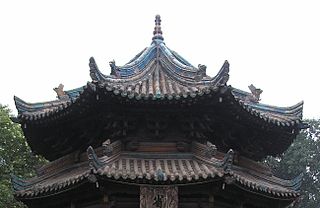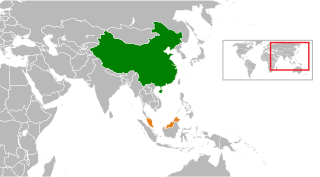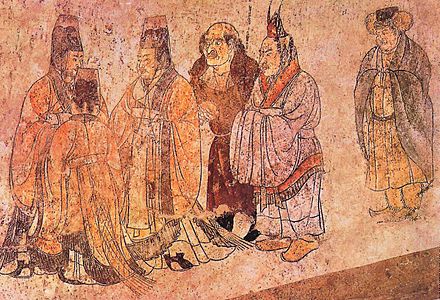
The Malacca Sultanate was a Malay sultanate centred in the modern-day state of Malacca, Malaysia. Conventional historical thesis marks c. 1400 as the founding year of the sultanate by a Malay Raja of Singapura, Parameswara, also known as Iskandar Shah. At the height of the sultanate's power in the 15th century, its capital grew into one of the most important entrepots of its time, with territory covering much of the Malay Peninsula, the Riau Islands and a significant portion of the northern coast of Sumatra in present-day Indonesia.

A tribute (/ˈtrɪbjuːt/) is wealth, often in kind, that a party gives to another as a sign of respect or, as was often the case in historical contexts, of submission or allegiance. Various ancient states exacted tribute from the rulers of land which the state conquered or otherwise threatened to conquer. In case of alliances, lesser parties may pay tribute to more powerful parties as a sign of allegiance and often in order to finance projects that would benefit both parties. To be called "tribute" a recognition by the payer of political submission to the payee is normally required; the large sums, essentially protection money, paid by the later Roman and Byzantine Empires to barbarian peoples to prevent them attacking imperial territory, would not usually be termed "tribute" as the Empire accepted no inferior political position. Payments by a superior political entity to an inferior one, made for various purposes, are described by terms including "subsidy".
Sinocentrism refers to the ideology that China is the cultural, political or economic center of the world.

The Mandate of Heaven or Tian Ming is a Chinese political and religious doctrine used since ancient times to justify the rule of the King or Emperor of China. According to this belief, heaven —which embodies the natural order and will of the universe—bestows the mandate on a just ruler of China, the "Son of Heaven" of the "Celestial Empire". If a ruler was overthrown, this was interpreted as an indication that the ruler was unworthy, and had lost the mandate. It was also a common belief among citizens that natural disasters such as famine and flood were signs of heaven's displeasure with the ruler, so there would often be revolts following major disasters as citizens saw these as signs that the Mandate of Heaven had been withdrawn.

The Nguyễn dynasty or House of Nguyễn was the final imperial family of Vietnam. Their ancestral line can be traced back to the beginning of the Common Era. However, only by the mid-sixteenth century the most ambitious family branch, the Nguyễn Lords had risen to conquer, control and establish feudal rule over large territory.

Korean Confucianism is the form of Confucianism that emerged and developed in Korea. One of the most substantial influences in Korean intellectual history was the introduction of Confucian thought as part of the cultural influence from China. Today the legacy of Confucianism remains a fundamental part of Korean society, shaping the moral system, the way of life, social relations between old and young, high culture, and is the basis for much of the legal system. Confucianism in Korea is sometimes considered a pragmatic way of holding a nation together without the civil wars and internal dissent that were inherited from the Goryeo dynasty.
Tianxia is a Chinese term for an ancient Chinese cultural concept that denoted either the entire geographical world or the metaphysical realm of mortals, and later became associated with political sovereignty. In ancient China, tianxia denoted the lands, space, and area divinely appointed to the Emperor by universal and well-defined principles of order. The center of this land was directly apportioned to the Imperial court, forming the center of a world view that centered on the Imperial court and went concentrically outward to major and minor officials and then the common citizens, tributary states, and finally ending with the fringe "barbarians".

Son of Heaven, or Tian Zi, was the sacred imperial title of the Chinese emperor. It originated with the ancient Zhou dynasty and was founded on the political and spiritual doctrine of the Mandate of Heaven. The secular imperial title of the Son of Heaven was "Emperor of China".
Over the last four thousand years Chinese imperialism and expansion has been a central feature of the history of East Asia. Since the recovery of Chinese strength in the late 20th century the issues involved, have been of concern to China's neighbors to the east.

The Hồ dynasty was a short-lived six-year reign of two emperors, Hồ Quý Ly in 1400–01 and his second son, Hồ Hán Thương, who reigned from 1401 to 1406. The practice of bequeathing the throne to a designated son was similar to what had happened in the previous Trần dynasty and was meant to avoid sibling rivalry. Hồ Quý Ly's eldest son, Hồ Nguyên Trừng, played his part as the dynasty's military general. In 2011, UNESCO declared the Citadel of the Hồ Dynasty in Thanh Hóa Province a world heritage site.

As the Yuan dynasty ended, many Mongols as well as the Muslims who came with them remained in China. Most of their descendants took Chinese names and became part of the diverse cultural world of China. During the following Ming rule (1368–1644), Muslims truly adopted Chinese culture. Most became fluent in Chinese and adopted Chinese names and the capital, Nanjing, became a center of Islamic learning. As a result, the Muslims became "outwardly indistinguishable" from the Chinese.

The four occupations or "four categories of the people" was an occupation classification used in ancient China by either Confucian or Legalist scholars as far back as the late Zhou dynasty and is considered a central part of the fengjian social structure. These were the shi, the nong, the gong, and the shang . The four occupations were not always arranged in this order. The four categories were not socioeconomic classes; wealth and standing did not correspond to these categories, nor were they hereditary.

The Ming dynasty, officially the Great Ming or Empire of the Great Ming, founded by the peasant rebel leader Zhu Yuanzhang, known as the Hongwu Emperor, was an imperial dynasty of China. It was the successor to the Yuan dynasty and the predecessor of the short-lived Shun dynasty, which was in turn succeeded by the Qing dynasty. At its height, the Ming dynasty had a population of 160 million people, while some assert the population could actually have been as large as 200 million.
The Cham-Đại Việt War of 1471 was a military expedition launched by Emperor Lê Thánh Tông of Đại Việt, and is widely regarded as the event that marked the downfall of Champa. The Đại Việt forces attacked and sacked the kingdom's largest city-state, Vijaya, and defeated the Cham army. When the conflict was resolved, Champa was forced to cede territory to Annam, and was no longer a threat to Annamese territory.

China–Malaysia relations refers to bilateral foreign relations between the two countries, China and Malaysia.
The distinction between Huá and Yí, also known as Sino–barbarian dichotomy, is an ancient Chinese concept that differentiated a culturally defined "China" from cultural or ethnic outsiders. Although Yí is often translated as "barbarian", other translations of this term in English include "foreigners", "ordinary others" "wild tribes", and "uncivilized tribes". The Hua–Yi distinction asserted Chinese superiority, but implied that outsiders could become Hua by adopting Chinese values and customs.
Gyorin was a neo-Confucian term developed in Joseon Korea. The term was intended to identify and characterize a diplomatic policy which establishes and maintains amicable relations with neighboring states. It was construed and understood in tandem with a corollary term, which was the sadae or "serving the great" policy towards Imperial China.

Sojunghwa is a 17th century Korean concept that means "Little China" referring to the Joseon Dynasty. After the Manchu-ruled Qing dynasty conquered the Han Chinese-ruled Ming dynasty, Koreans thought that barbarians ruined the center of civilization of the world and so Confucianist Joseon Korea had become the new center of the world, replacing Ming China hence the name "Little China." Tokugawa Japan and Vietnam also had a similar belief in themselves after the Qing Dynasty had taken over China.




















